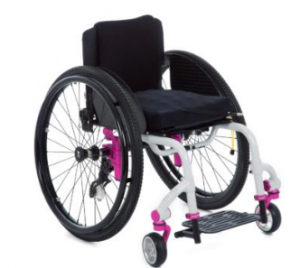
How do you order a wheelchair?
The process of wheelchair ordering is complex and it can take as long as 8 months or more to move the process through the system from original order to the arrival of the new wheelchair. Depending on where you live, what type of insurance coverage you have, and what your mobility needs are, your process will vary. For many, the starting place is a prescription for a wheelchair from the pediatrician or general practitioner, who will not likely know much about what to write on the prescription. Therefore, it’s important that you already have some ideas about what would be best. That way, if a custom ultra-light rigid wheelchair is what you are aiming for, then you can tell your doctor to write that on the prescription. Ensure that the prescription you receive from the doctor specifies details with words such as “rigid” (rigid chairs actually fold down smaller than “folding” chairs but are more durable than “folding” chairs) and “ultra-light” (unless you like a chair that weighs more than you do). Sometimes the wheelchair ordering process happens through an appointment at an orthopedic clinic, where someone such as a case manager will help you initiate the process.
Once that prescription is received by the insurance company, there will be some extensive paperwork that needs to be completed to justify the order. If the insurance company does provide for “durable medical equipment”, they will only provide a basic folding hospital type chair. Once you specify a custom chair in the prescription, a seating evaluation has to be done to justify that order. Here is an example of a seating evaluation form. A seating specialist or physical therapist does this evaluation. Sometimes these individuals work for the companies that distribute specific brands of chairs. If you have choices as to which seating specialist you use, it’s a good idea to explore their products and the wheelchair manufacturers they work with. Unfortunately most are not trained in specific needs for wheelchair seating of those with SA/CRS, so there are many potential errors when the order differs from the “standard” type of seating measurements that they are used to providing. At the seating evaluation appointment, it is important to share your perspectives about the type of chair needed and why. Research wheelchair manufacturing companies and compare their products so that you know what to ask for in the seating evaluation. Make sure you point out unique needs related to center of gravity, seat depth, seat width and the mounting height of the foot plate.
Before agreeing to order a wheelchair from a particular company, do your research. A seating specialist can write the seating evaluation to support the need for a specific type of chair design. Check with consumers about their experiences with the chair, customer service, fitting specifications and so on. Find out what kinds of features you need and what you don’t need. Remember, for wheelchairs, more is “heavy”, not “better”, when it comes to adding on extras. If you are determined to have a specific brand of chair, it may be best to work backwards, starting by talking to that company about how to process an order for the chair through your insurance company and let them advise you on the process.
Once the seating evaluation has been completed, you will use that to work with the company on the order. The company representative will write up an order from. These orders can be complex, as seen in this example Some features insurance companies will not pay for, such as customized colors.
Pay special attention to the order form details. There is nothing worse than ordering a chair without push handles only to have the chair arrive with push handles, or to order a chair that you thought had a locking back, only to find that the back of the chair collapses every time you push on it. The representative will be looking for you to sign this order form, so take your time to discuss each detail with the representative to make sure that you understand the options and why certain options are chosen before you sign it. Each order will be a learning experience so that you know in the future what you might make changes to for improvements. Keep your order form copy as a reference.
Examples of wheelchair features you will need to consider.
| Seat Width | push handles | |
| Seat Depth | side guards | |
| Front seat height | brakes | |
| Rear seat height | footplate | |
| Back height | wheel type | |
| Overall Width | wheel camber | |
| Overall Length | push rim | |
| Lower leg length | seat cushion | |
| Frame type | wheel release | |
| wheel size | tire insert | |
| Back Angle | caster wheel | |
| Frame Angle | axle | |
| Additional Growth | back upolstery | |
| Tires | leg strap | |
| grab bar | anti-tip bars | |
| seat belt | center of gravity | |
| arm rests | front forks | |
| push assist device |
photo attribution: Permobile.com-Tilite
